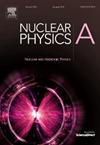简莎:过去、现在和未来
IF 1.7
4区 物理与天体物理
Q2 PHYSICS, NUCLEAR
引用次数: 0
摘要
核反应研究依赖于三个主要的物理组成部分:由设施提供的原子核束,用于测量出射粒子的探测系统,以及目标。因此,目标制造是研究动力恒星反应和探索核结构演变的关键方面。JENSA (Jet Experiments in Nuclear Structure and Astrophysics)气体喷射靶是目前世界上用于稀有同位素束反应研究的密度最大的氦喷射靶,提供了氦、氮、氖等气态元素的靶。简要介绍了JENSA的设计和运行,包括调试和最近的科学实验,并讨论了JENSA与专用后坐力分离器SECAR耦合的未来。本文章由计算机程序翻译,如有差异,请以英文原文为准。
JENSA: Past, present, and future
Nuclear reaction studies rely on three main physical components: the beam of nuclei provided by the facility, the detector systems used to measure the outgoing particles of interest, and the target. Target fabrication is thus a critical aspect of studying the reactions that power stars and probe the evolution of nuclear structure. The Jet Experiments in Nuclear Structure and Astrophysics (JENSA) gas jet target is the most dense helium jet target for rare isotope beam reaction studies in the world, providing targets of gaseous elements such as helium, nitrogen, and neon. A brief overview of the design and operation of JENSA, including commissioning and recent science experiments, and a discussion the future of JENSA coupled to the dedicated recoil separator SECAR, are presented.
求助全文
通过发布文献求助,成功后即可免费获取论文全文。
去求助
来源期刊

Nuclear Physics A
物理-物理:核物理
CiteScore
3.60
自引率
7.10%
发文量
113
审稿时长
61 days
期刊介绍:
Nuclear Physics A focuses on the domain of nuclear and hadronic physics and includes the following subsections: Nuclear Structure and Dynamics; Intermediate and High Energy Heavy Ion Physics; Hadronic Physics; Electromagnetic and Weak Interactions; Nuclear Astrophysics. The emphasis is on original research papers. A number of carefully selected and reviewed conference proceedings are published as an integral part of the journal.
 求助内容:
求助内容: 应助结果提醒方式:
应助结果提醒方式:


